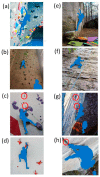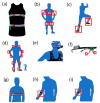Wearable and Non-Invasive Sensors for Rock Climbing Applications: Science-Based Training and Performance Optimization
- PMID: 37299807
- PMCID: PMC10255440
- DOI: 10.3390/s23115080
Wearable and Non-Invasive Sensors for Rock Climbing Applications: Science-Based Training and Performance Optimization
Abstract
Rock climbing has evolved from a method for alpine mountaineering into a popular recreational activity and competitive sport. Advances in safety equipment and the rapid growth of indoor climbing facilities has enabled climbers to focus on the physical and technical movements needed to elevate performance. Through improved training methods, climbers can now achieve ascents of extreme difficulty. A critical aspect to further improve performance is the ability to continuously measure body movement and physiologic responses while ascending the climbing wall. However, traditional measurement devices (e.g., dynamometer) limit data collection during climbing. Advances in wearable and non-invasive sensor technologies have enabled new applications for climbing. This paper presents an overview and critical analysis of the scientific literature on sensors used during climbing. We focus on the several highlighted sensors with the ability to provide continuous measurements during climbing. These selected sensors consist of five main types (body movement, respiration, heart activity, eye gazing, skeletal muscle characterization) that demonstrate their capabilities and potential climbing applications. This review will facilitate the selection of these types of sensors in support of climbing training and strategies.
Keywords: biomonitoring; bouldering; breathing sensors; cardiac sensors; external and embedded sensors; non-invasive sensors; outdoor climbing; physical sensors; rock climbing; speed climbing; sport climbing; wearable sensors.
Conflict of interest statement
The authors declare no conflict of interest.
Figures





Similar articles
-
Integrating Wearable Sensors and Video to Determine Microlocation-Specific Physiologic and Motion Biometrics-Method Development for Competitive Climbing.Sensors (Basel). 2022 Aug 20;22(16):6271. doi: 10.3390/s22166271. Sensors (Basel). 2022. PMID: 36016034 Free PMC article.
-
Mechanisms underlying superior memory of skilled climbers in indoor bouldering.J Sports Sci. 2023 Oct;41(20):1837-1844. doi: 10.1080/02640414.2023.2300569. Epub 2024 Jan 2. J Sports Sci. 2023. PMID: 38166602
-
Body Composition, Anthropometric Parameters, and Strength-Endurance Characteristics of Sport Climbers: A Systematic Review.J Strength Cond Res. 2023 Jun 1;37(6):1339-1348. doi: 10.1519/JSC.0000000000004464. Epub 2023 Mar 17. J Strength Cond Res. 2023. PMID: 36930882 Free PMC article.
-
Heart Rate Response, Duration, Grip Strength, and Anthropometric Characteristics in Recreational Indoor Rock Climbers.J Strength Cond Res. 2022 Mar 1;36(3):832-837. doi: 10.1519/JSC.0000000000003540. J Strength Cond Res. 2022. PMID: 35180193
-
The physiology of rock climbing.Sports Med. 2006;36(6):529-45. doi: 10.2165/00007256-200636060-00006. Sports Med. 2006. PMID: 16737345 Review.
Cited by
-
Towards Automatic Object Detection and Activity Recognition in Indoor Climbing.Sensors (Basel). 2024 Oct 8;24(19):6479. doi: 10.3390/s24196479. Sensors (Basel). 2024. PMID: 39409520 Free PMC article.
-
Climbing Technique Evaluation by Means of Skeleton Video Stream Analysis.Sensors (Basel). 2023 Oct 1;23(19):8216. doi: 10.3390/s23198216. Sensors (Basel). 2023. PMID: 37837046 Free PMC article.
-
Detection of Lowering in Sport Climbing Using Orientation-Based Sensor-Enhanced Quickdraws: A Preliminary Investigation.Sensors (Basel). 2024 Jul 15;24(14):4576. doi: 10.3390/s24144576. Sensors (Basel). 2024. PMID: 39065974 Free PMC article.
-
Gaze Estimation Based on Convolutional Structure and Sliding Window-Based Attention Mechanism.Sensors (Basel). 2023 Jul 7;23(13):6226. doi: 10.3390/s23136226. Sensors (Basel). 2023. PMID: 37448073 Free PMC article.
References
-
- Verified Market Research Global Wearable Sensors Market Size by Type (Accelerometer, Gyroscope, Optical, Force and Pressure), by Device (Smart Watch, Fitness Band, Smart Glasses), by Vertical (Consumer, Defense, Healthcare, Industrial), by Geographic Scope and Forecast. Report 35124. May 2022. [(accessed on 23 February 2023)]. Available online: https://www.verifiedmarketresearch.com/product/wearable-sensors-market/
-
- Pranaclimb. [(accessed on 23 February 2023)]. Available online: https://pranaclimb.com/how-fast-we-are-breathing-indicates-how-hard-we-p...
-
- International Federation of Sport Climbing IFSC 2021 Annual Report. [(accessed on 23 February 2023)]. Available online: https://www.ifsc-climbing.org/index.php/news/2-uncategorised/282-annual-....
-
- Michael M.K., Witard O.C., Joubert L. Physiological demands and nutritional considerations for Olympic-style competitive rock climbing. Cogent Med. 2019;6:1667199. doi: 10.1080/2331205X.2019.1667199. - DOI
Publication types
MeSH terms
LinkOut - more resources
Full Text Sources

